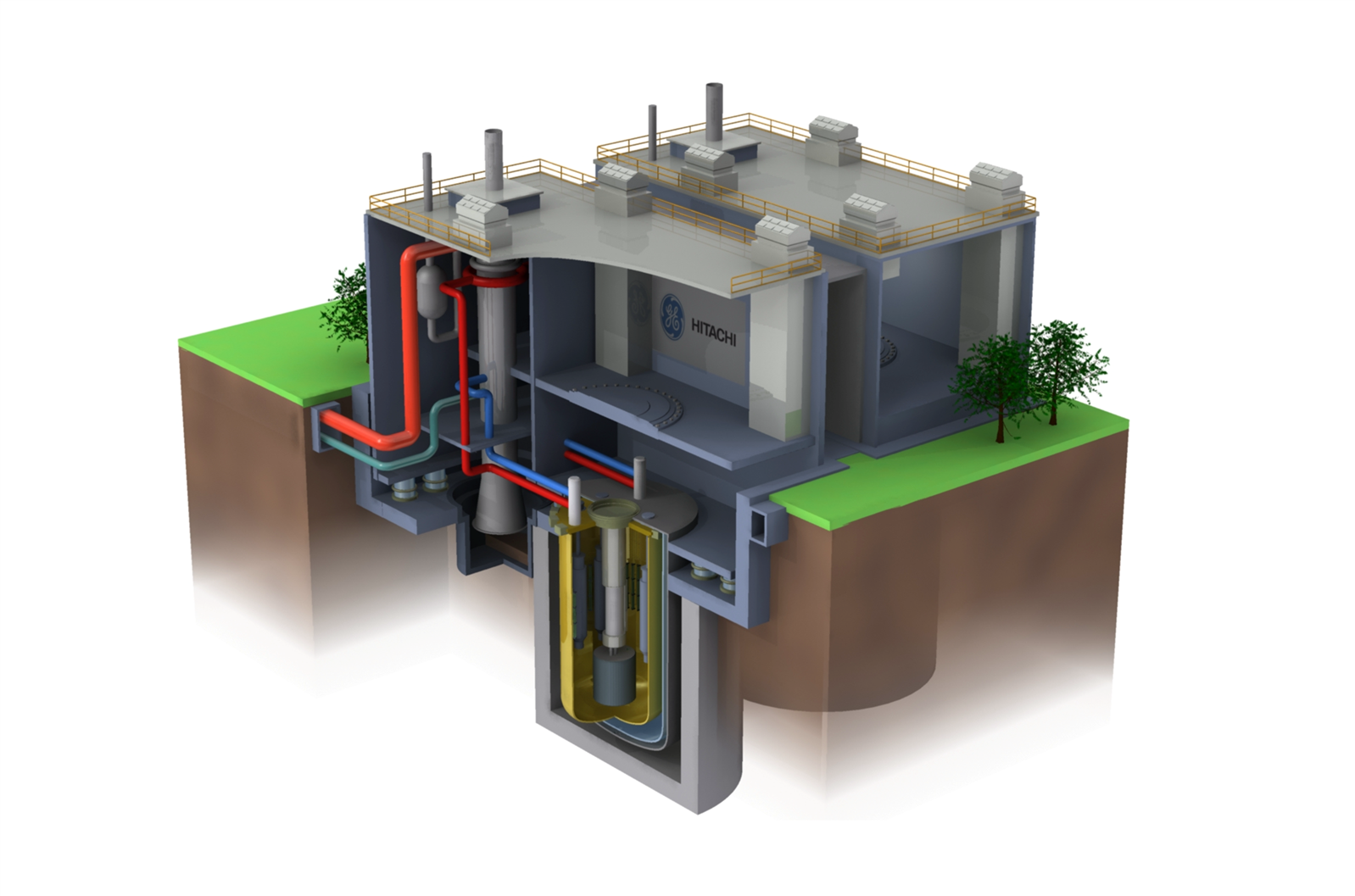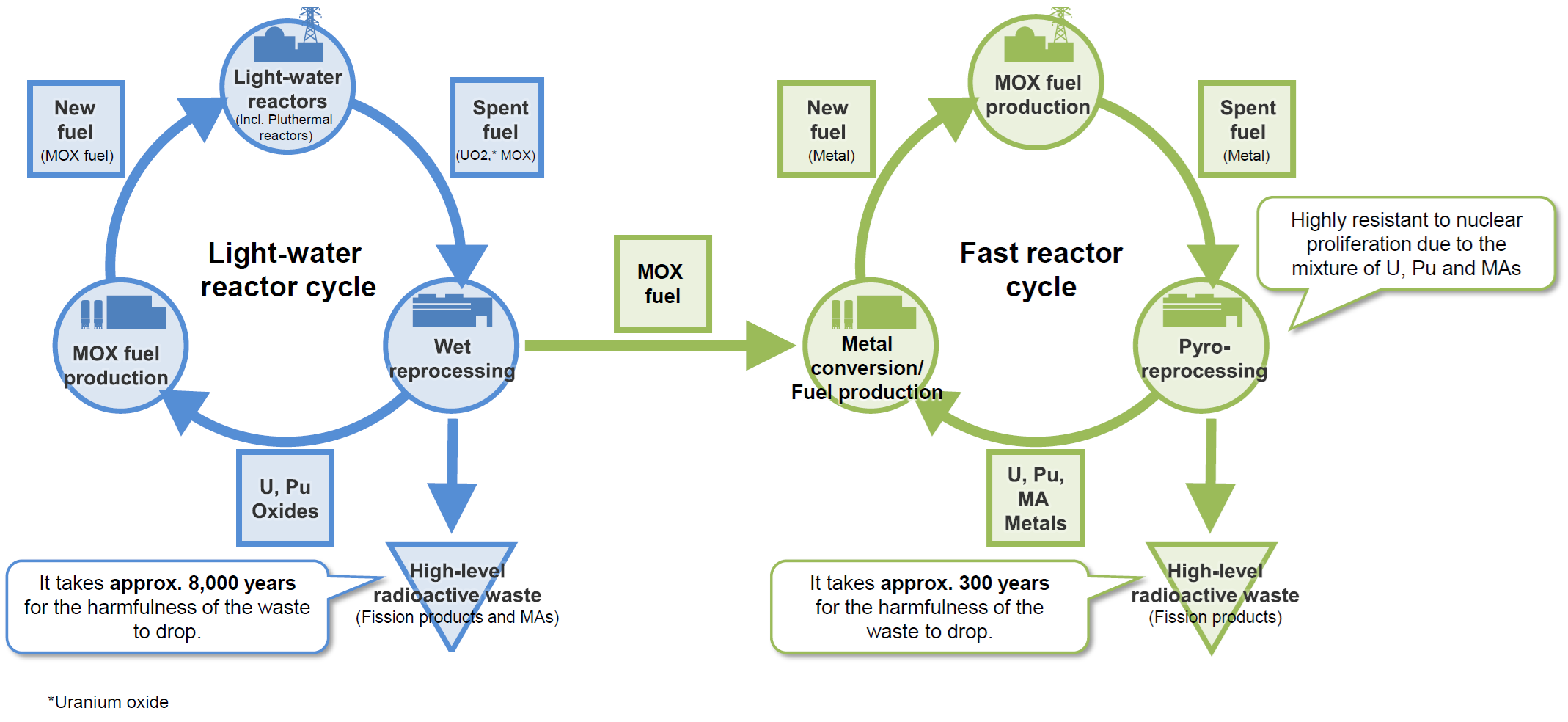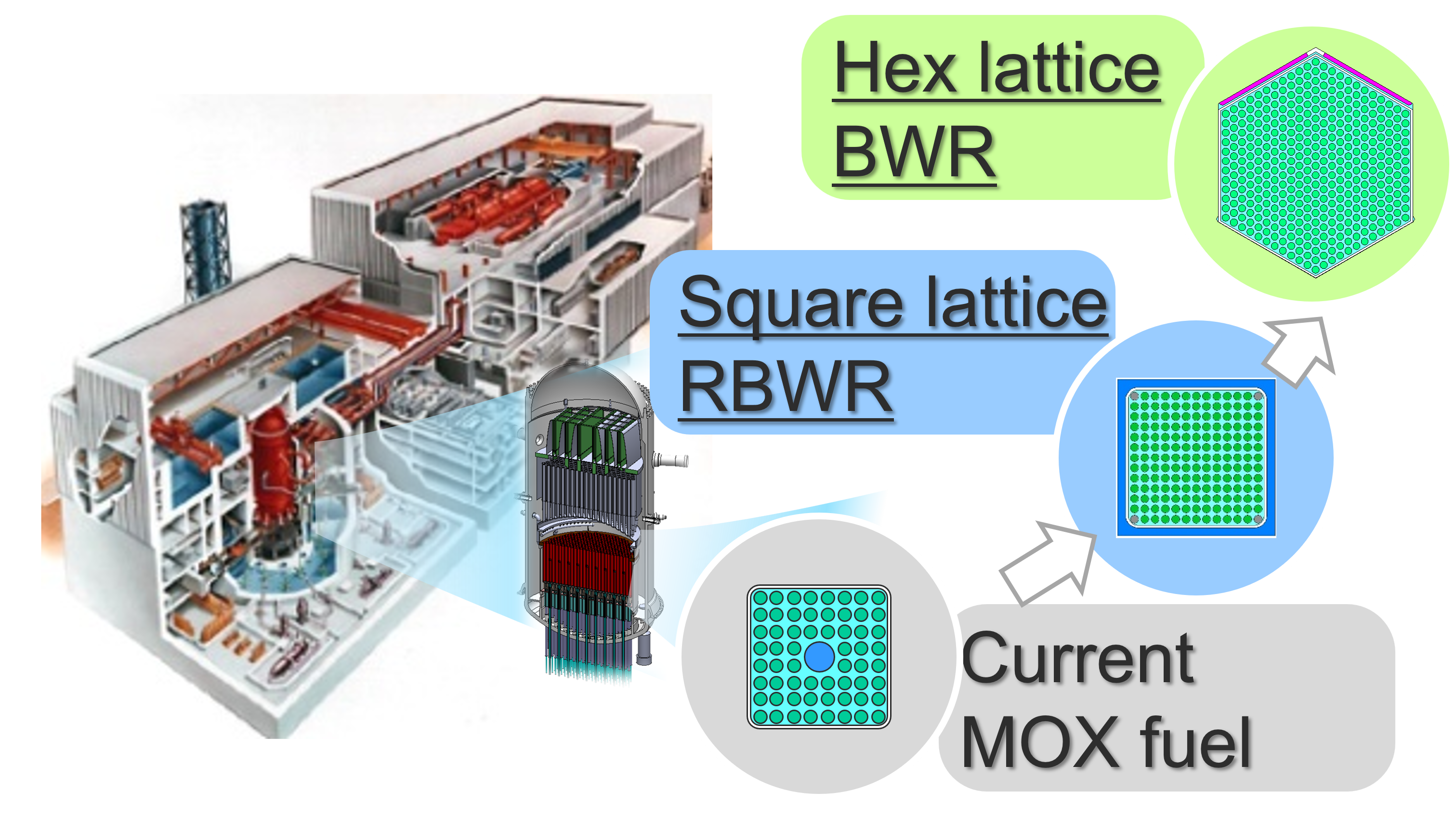
Expectations regarding nuclear power generation are growing as progress is made in the departure from fossil fuels as society moves toward the achievement of carbon neutrality by 2050. Because nuclear energy does not emit CO2 during power generation and makes it possible to stably supply power, it is expected to be used as a baseload power source. In addition, Japan is a fossil fuel importer and it must improve its energy self-sufficiency rate by increasing the ratio of nuclear power generation in the energy mix from the perspective of reducing geopolitical risks. Hitachi is developing fast reactors and fuel cycle technology for the safer, longer-term use of nuclear energy whose importance is increasing.
We interviewed Mr. Kenji Noshita, the Department Manager of the Fast Reactor & Fuel Cycle Development Center, which is a part of the Fukushima & Fuel Cycle Business Development & Management Division of Hitachi-GE Nuclear Energy, Ltd., who is implementing this project. We asked him about key points of technology development and future prospects.
— Why is nuclear energy needed now? Please tell us about the situation surrounding energy.
At the COP28 UN Climate Change Conference (World Climate Action Summit of the 28th Conference of the Parties to the U.N. Framework Convention on Climate Change) in 2023, various countries jointly launched the declaration to triple the nuclear energy capability by 2050, in addition to building their renewable energy capacity. This declaration reflects delays in actions to achieve the goal of limiting global temperature rise to 1.5 °C. At COP 29 in 2024, related countries discussed funding for this Declaration to Triple Nuclear Energy, exemplifying the fact that the importance of nuclear energy is attracting further attention. While it is moving to increase the amount of renewable energy generated, the amount of power generated using these technologies differs according to the weather and time of the day, so nuclear energy is believed to be a baseload power source because it makes it possible to stably supply power without emitting CO2 during power generation. Attempts are therefore being made to increase the nuclear energy output. It can safely be said that this is a part of the global trend towards carbon neutrality.
In addition, Japan is a fossil fuel importer, and soaring energy prices is an issue faced in Japan amid the spate of international conflicts. It is also necessary to reduce dependence on fossil fuels and increase energy self-sufficiency by generating nuclear power to reduce geopolitical risk. In February 2025, Japan's cabinet made a decision on the Seventh Strategic Energy Plan, which says that nuclear energy shall be "fully exploited" together with renewable energy, with the FY2040 target for the percentage of nuclear power generation in the energy mix being around 20%.
— Currently, it is also expected that power demand will rapidly increase due to the plans to construct data centers reflecting the popularization of generative AI, yes?
That's right. The Seventh Strategic Energy Plan assumes that the power output in FY2040 will be 10% to 20% greater than in FY2023 due to progress in DX and GX. Demand for nuclear energy is growing globally as well, as it makes it possible to stably supply power generation with its constant output. Securing uranium resources, which are the fuel for nuclear reactors, has increased in importance and the price of uranium rose sharply in 2023. In the long run, it is expected that nuclear energy will be used even more widely around the world in the 2080s and 2090s. Therefore, there are concerns that nuclear power generation, which is fueled by uranium, a limited resource, will no longer be constantly available.
I believe that, among the new nuclear technologies being developed, fast reactors and fuel cycles are extremely effective for using limited uranium resources efficiently and increasing the energy self-sufficiency rate. Fast reactors are a great technological innovation in the field of nuclear energy. Combined with fuel cycle technology, it makes it possible to reuse most fuel, enabling energy self-sufficiency to be maintained for thousands of years.
To continue to use nuclear energy safely for the long term, it is essential to reduce the harmfulness of high-level radioactive waste (by shortening the half-life of radioactive waste significantly) and reduce the amount (volume) of waste. These are tasks to be done immediately, in addition to the efficient use of resources. Hitachi is developing innovative fast reactors and fuel cycles as effective technologies for addressing these challenges.
— What are fast reactors and fuel cycles? How do they make it possible to efficiently use resources and reduce the harmfulness and volume of high-level radioactive waste?
In the widely used light-water nuclear reactors today, fast neutrons generated by a fission reaction are slowed down in light water (ordinary water) to create thermal neutrons. These neutrons are used to induce a fission reaction, and the energy generated in this way is used. In contrast, fast reactors induce a fission reaction using fast neutrons without slowing them down. Using fast neutrons, which have 10 million times more energy than thermal neutrons, makes it possible to extract more energy from the fuel and reduces the amount of harmful radioactive substances with long half-lives. This helps increase the completeness of the fuel cycle.
The fuel cycle is the process in which the fuel used in nuclear power generation (spent fuel) is reprocessed and used again for nuclear power generation. Spent fuel contains uranium which has yet to undergo fission, plutonium that was generated in the nuclear reactor, and other substances. These substances are recovered and used again as fuel for nuclear power generation, making it possible to efficiently use resources. At present, Japan Nuclear Fuel Limited is building a reprocessing plant in Rokkasho-mura, Aomori prefecture, Japan. The Pluthermal Plan is a plan to use oxidized fuel (MOX fuel) at existing nuclear power plants (light-water reactors). This fuel is a mixture of plutonium and uranium recovered by reprocessing spent fuel.
Let me tell you why fast reactors and fuel cycles are important. If spent fuel from a light-water reactor is disposed of directly without fuel cycles, it takes up to 100,000 years for the harmfulness of the radioactive waste to drop to the level of natural uranium. In contrast, in the light-water reactor cycle combining light-water reactors and its fuel cycle, uranium and plutonium are recovered by reprocessing spent fuel and reused as MOX fuel. Minor actinides (MAs), including transuranium elements such as americium, curium, and neptunium, which have long half-lives, and fission products remain in spent fuel. Handled as high-level radioactive waste, they are converted into vitrified waste and stored and cooled for hundreds of years before being disposed of geologically. Handled this way, it will take approx. 8,000 years before their harmfulness is reduced.
However, using the fast reactor cycle combining fast reactors and its fuel cycle, MAs, in addition to uranium and plutonium, can be burned as fuel. This means that only fission products are disposed of as high-level radioactive waste. This significantly shortens the time it takes for the harmfulness of waste to decrease—to approx. 300 years.

Fuel cycles use resources efficiently and reduce the harmfulness and amount of radioactive waste
Fuel cycles make it possible to reduce the amount (volume) of high-level radioactive waste because uranium, plutonium, etc., which constitute the majority of spent fuel, are recovered and reused, even in the light-water reactor cycle. Further, the fast reactor cycle makes it possible to generate more power than light-water reactors using the same amount of fuel. This further reduces the radioactive waste per unit of output. The combustion of MA not only ensures the volume of waste is reduced, but it also reduces the area of the sites that are needed for the geological disposal of the waste, which is a great benefit.
— Why is it possible to reduce the area of the disposal site?
MAs continue to radiate heat for hundreds of years, even as vitrified waste. Therefore, in the light-water reactor cycle, there must be a lot of space left between the radioactive waste (vitrified waste) containers, so a large disposal site is needed. In contrast, in the fast reactor cycle, MAs are used as fuel and reused continually. This means that the waste does not contain MAs and generates less heat, permitting less space between waste containers, a smaller disposal site, and a longer time before a new disposal site needs to be prepared.
Fuel cycles make it possible to repeatedly use (recycle) spent fuel. Above all, the fast reactor cycle translates into a form of recycling with an extremely high level of completeness.
— What kinds of fast reactors are you developing?
At Hitachi-GE Nuclear Energy, we are developing two types of fast reactor. One is an innovative small sodium-cooled fast reactor (Power Reactor Innovative Small Module: PRISM). The other is a light-water-cooled fast reactor (Resource-renewable BWR: RBWR) . I will first explain PRISM and the metal fuel cycle, the fast reactor cycle which uses PRISM.
As the name suggests, the innovative small sodium-cooled fast reactor (PRISM) uses liquid-metal sodium to cool the nuclear reactor. We will create small modular reactors with relatively low output and combine them to achieve high output and economic efficiency. Liquid-metal sodium is close to water in terms of density and viscosity, but it has a higher boiling point. There are various benefits because of this, such as there being no need to make the reactor resistant to high pressure, the pipes being resistant to corrosion, high thermal conductivity and there being no hydrogen emissions, even in an accident. This type of reactor is being developed by GE Hitachi Nuclear Energy, Ltd. of the U.S., a joint venture between Hitachi, Ltd. and GE Vernova Inc. We are now engaged in development efforts to introduce the reactor in Japan.
Additionally, the reactor is equipped with a reactor vessel auxiliary cooling system (RVACS), which makes power supply and operations unnecessary in the event of an accident and enables long-term reactor core cooling. It is also a highly excellent system in terms of economic efficiency and the efficient use of resources.

Power Reactor Innovative Small Module (PRISM)
— What need to be developed to introduce PRISM in Japan?
General Electric (GE) began developing PRISM technology in the 1980s, and these efforts have been continued by GE Hitachi Nuclear Energy. A design has been completed and a preliminary license has been granted by the U.S. regulatory authority. As I will explain later, it has been selected to be a part of the U.S. Advanced Reactor Demonstration Program (ARDP), and development in the U.S. is leading the way.
However, to introduce PRISM in Japan, we need to continue to develop the technology so that it conforms with Japan's new regulatory standards. For example, standards regarding safety against accidents and seismic standards are different between the U.S. and Japan, so unique technologies must be developed.
The fuel is also different from that used in the U.S. While only uranium is used in the U.S., fuels containing plutonium and MAs are used for operations in Japan to enable the fast reactor cycle that I mentioned earlier. Therefore, we are engaged in R&D for the design of a reactor core that is compatible with the fuels that will be used.
— What is a metal fuel cycle?
As I explained fuel cycles earlier, a light-water reactor cycle includes wet reprocessing, with which spent fuel, an oxide, is dissolved into a water solution to separate and recover uranium and plutonium. The separated uranium and plutonium are made into MOX fuel and used in light-water reactors. In contrast, in a metal fuel cycle, MOX fuel that is recovered through the light-water reactor cycle is converted into metal. The initial metal fuel that is produced is used in fast reactors. After it is used, the metal fuel undergoes pyro-reprocessing using metallurgical smelting technologies to recover uranium, plutonium and MAs to produce new metal fuel. This metal fuel cycle makes the electrochemical processing of molten salt (salt liquefied at high temperature) possible, which makes it possible for the equipment to be compact.

Outline of the light-water reactor cycle and the fast reactor cycle
Another feature of pyro-reprocessing is what we call nuclear proliferation resistance. It is very convenient from the viewpoint of nuclear non-proliferation. Wet reprocessing includes the separation and recovery of uranium and plutonium and the removal of just the plutonium. As you know, plutonium can be used to produce nuclear weapons, so it must be controlled extremely strictly. In a metal fuel cycle, uranium, plutonium and MAs are mixed together, being high-level radioactive. It is therefore technologically difficult to extract just the plutonium, so the nuclear proliferation resistance is high.
The Central Research Institute of the Electric Power Industry initially learned basic metal fuel cycle technology from the U.S. Through improvements achieved in Japan, it was developed as a reprocessing technology particularly for plutonium and MAs. Hitachi has been involved in wet reprocessing for a long time, but is engaging in the pyro-reprocessing of metal fuel for the first time. We are working to develop technologies with the Central Research Institute of the Electric Power Industry providing a range of technical guidance.
— You said that the development of PRISM is moving ahead in the U.S. What is the situation like in the U.S. now?
GE Hitachi Nuclear Energy and TerraPower, a U.S. nuclear energy startup, are jointly developing a nuclear reactor named Natrium using sodium-cooled fast reactor technologies based on PRISM technologies. Natrium will be used with TerraPower's molten salt energy storage system. This will result in a system that can increase the output to 500,000 kW and operate for more than 5.5 hours during peak power demand periods. Natrium was selected to be a part of the U.S. Advanced Reactor Demonstration Program (ARDP), and the groundbreaking ceremony was held in June 2024. TerraPower is now pushing ahead with the development of the project, aiming to begin operating in around 2030.
For Natrium, GE Hitachi Nuclear Energy supports the design of and acquisition of approvals for the nuclear reactor. At Hitachi-GE Nuclear Energy, we have been providing support for the project since April 2024, such as the dispatch of engineers to TerraPower. Because this is the first fast reactor that TerraPower is building, it is highly welcoming our wealth of design and manufacturing experience. Now that we know which fields they need assistance in, we are considering stepping up our provision of support.
Accordingly, the PRISM concept will be validated by the ARDP in the U.S. We would like to use the achievements and knowledge gained through this project in our development efforts for introducing PRISM in Japan.
Liquid-metal sodium, which is used to cool nuclear reactors, offers an advantage for molten salt energy storage systems. Liquid-metal sodium has extremely high heat conductivity, more than 100 times higher than water. When heated in a nuclear reactor, the temperature of liquid-metal sodium exceeds 500 °C, so it is possible to store it as a molten salt using a heat exchanger. In other words, energy can be stored in the form of heat. To date, nuclear power plants have just continued to generate power at a constant rate, but heat storage will enable them to produce the necessary amount of power when needed, making high value-added uses possible.

Kenji Noshita
Department Manager of the Fast Reactor & Fuel Cycle Development Center,
Fukushima & Fuel Cycle Business Development & Management Division, Hitachi-GE Nuclear Energy, Ltd.
— What kind of technology is used for the light-water-cooled fast reactor (RBWR), the other kind of fast reactor?
Hitachi began developing the light-water-cooled fast reactor (RBWR) more than 30 years ago to use the existing boiling-water reactor (BWR) technology to efficiently use resources and reduce the volume of radioactive waste, which was the original reason for developing fast reactors. Recently, we have been developing it as a technology for supporting the Pluthermal Plan of 11 domestic electric power companies. The goal of the plan is to use the maximum amount of plutonium as quickly as possible. We have also been developing it as a technology for smoothly transitioning to fast reactors. The purpose of the development efforts is to facilitate the reduction of the volume of spent fuel by using more plutonium than pluthermal BWRs use.
As I explained earlier, while a light-water reactor extracts energy by inducing a fission reaction involving thermal neutrons that have been slowed down using light water (ordinary water), a fast reactor uses high-energy fast neutrons that have not been slowed down. RBWR uses higher-energy neutrons by inhibiting light water's slowing of the neutrons by using fuel in a tightly arranged group of fuel pins (tight-lattice fuel). This enables more plutonium to be used than in a light-water reactor and the combustion of MAs. It is possible to practically use RBWR more quickly because they use light-water cooling technology, something Hitachi-GE Nuclear Energy, a BWR manufacturer, has an extensive history in, and current technology can be used in sections other than the reactor core, such as the turbines and safety systems. The current technology for reprocessing spent fuel and the MOX fuel manufacturing technology can also be used.
Regarding tight-lattice fuels, we plan to develop square and hexagonal lattice fuels with an even tighter arrangement of fuel pins than the current MOX fuel for pluthermal reactors.
It is possible to use quadrangular grid RBWR fuel just by replacing the reactor core of existing BWRs or replacing/installing components. Further, the current technology for reprocessing spent fuel and manufacturing MOX fuel can be used, making it possible to practically use these reactors more quickly. Following up on this, we will strive to achieve the practical use of hexagonal grid RBWRs, which will contribute more significantly to the efficient use of resources and the reduction of the volume of spent fuel in line with the progress in reprocessing, fuel manufacturing, and other technologies.

RBWR light-water-cooled fast reactor
— When do you think PRISM, metal fuel cycles, which use PRISM, and RBWR will be practically used in Japan?
We will act in line with Japanese government's policies. Regarding fast reactors, ideally the concept should be finalized by around 2030 and a demonstration reactor should begin operating by 2050, according to the Council on Fast Reactor Development's strategic roadmap, which was revised in December 2022. Development is now under way with core companies playing leading roles. We will also contribute to these efforts by providing technological assistance.
Speaking about the more distant future, the Atomic Energy Society of Japan is conducting a case study assuming that fast reactors will become more widespread in the 2060s. Therefore, we will leverage our experience in the Natrium project in the U.S. to move forward with development with the goal of introducing PRISM in Japan and making a metal fuel cycle a reality in or after 2050.
We aim to begin practically using RBWR by around 2045 as a technology for supporting the Pluthermal Plan and smoothly transitioning to sodium-cooled fast reactors, as I mentioned earlier.
— Finally, what are your aspirations and prospects for the future?
Fast reactors are a great technological innovation in the field of nuclear energy. They are also called dream nuclear reactors. The practical realization of fast reactors and their fuel cycle will enable us to maintain energy self-sufficiency for thousands of years. To make this dream come true, we will achieve goals, including the efficient use of resources and the mitigation of radioactive waste problems, thereby making nuclear energy acceptable to society. That is, we aim to create a state where we can continue to provide nuclear energy as sustainable energy.
Innovative fast reactors and fuel cycles are new fields for the sustainable co-existence of nuclear energy and society. Therefore, many human resources are needed to quickly achieve the practical use of these reactors. No one has ever tried to develop the technology for the fast reactor cycle, or, specifically, for the practical use of fast reactors. We may say that we are able to work in an extremely broad range of fields, including not only technology development but also collaboration with governments, overseas research institutions and overseas companies. We heartily hope that people who want to work and take on challenges in this broad range of fields will join us.
While we expect to face many hardships on the way toward the practical use of fast reactors, we believe that the technological issues will definitely be solved through our continuous efforts. Hitachi will press forward with the practical use of fast reactors and fuel cycle technologies to continue to provide safe and stable nuclear energy to society into the future.